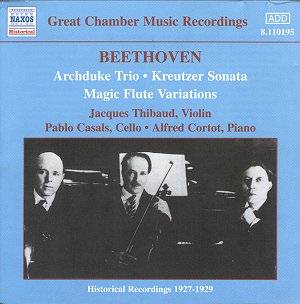It’s a measure of the paucity of recordings of the Cortot-Thibaud-Casals
trio – itself a direct result of their deliberately limited repertoire
– that this latest release in Naxos’s series has only one performance
by the Trio itself. This all-Beethoven affair presents the Archduke Trio,
supported by Thibaud and Cortot’s Kreutzer and the only recording ever
made by Casals and Cortot as a duo, the Mozart Variations.
The disc begins with the Kreutzer Sonata, recorded
unusually in the Salle Chopin and Salle Pleyel in Paris – the
recording locations changed over the two-day period though there’s no
audible change in acoustic. It’s always been a matter of profound regret
that Thibaud never recorded either the Beethoven Concerto or the Mozart
Sinfonia Concertante – a performance with his superb colleague, the
violist Maurice Vieux, must now remain just a dream – but the Kreutzer
does indicate directions and priorities in Thibaud’s Beethoven playing
from which we may be able to draw reasonable conclusions. His playing,
light, sweet, somewhat small in scale, sits at a somewhat rarefied tangential
remove from the more explosive central European or Russian approaches.
His gorgeously equalized scale is as ever a thing of wonder as is the
faint whiff of raffiné phrasing in the first movement. The opening
statement, for instance, is decidedly withdrawn – there’s nothing of
Huberman’s almost coarse projection, little of Heifetz’s febrile theatricality,
or the gaunt sobriety of many German players. Instead Thibaud avoids
the disruptive implosions that others find in the music though he’s
never immune from the quicksilver changes of direction implicit in it.
There are very occasional intonational problems but Thibaud’s lyrical
impress is always marvellous but for all the manifold felicities – Thibaud’s
elfin and floated tone, Cortot’s tremendously animated left hand in
the Variations second movement, the clarity and purposefulness of the
concluding part of that movement - and for all that the work ends in
conclusive strength there is still something missing of elemental power
and projection.
The Mozart variations are charmingly done by Casals
and Cortot – no balance problems, no disruptive mannerisms, though there
are some scuffs audible in the generally good transfers. The Archduke
features the trio in a performance of almost symphonic breadth. When
Casals re-recorded the work, in 1951 at the Perpignan Festival, he and
his colleagues Alexander Schneider and Eugene Istomin, albeit that they
played the first movement recapitulation, added an extraordinary ten
minutes to the 1929 recording, which already clocked in at over 35’54
minutes – Naxos’ timings are completely wrong when they claim it lasts
29’28. As ever the tonal disparities between Thibaud and Casals are
abundantly and often constructively, creatively part of the special
alchemy that made their recordings so distinctive. As a performance
there are some ensemble lapses but here in 1929 Casals was far less
inclined to linger over phrases, as he was to become, and retains a
gruff and powerful expressivity throughout, with Thibaud’s gorgeous
liquidity and sweetness of tone and Cortot’s agile and decisive pianism
adding their own unique pleasures. It’s true that Casals experiences
small intonational problems in the opening movement but nothing eclipses
the nobility or the trio’s control of the long line, though the extent
of the rhapsodic slow movement is surely questionable. It’s not, in
the end, an unambiguously great performance – even a contemporary performance,
recorded two years earlier by the Anglo-Australian trio of Albert Sammons,
W H Squire and William Murdoch [on Pearl GEM 0044] yields comprehensively
more coherence and tonal congruity, tighter in tempo relationships and
structure. Nevertheless this is still a marvellous opportunity to hear
the Cortot-Thibaud-Casals trio individually and collectively as Beethovenians
of solid accomplishment.
Jonathan Woolf


